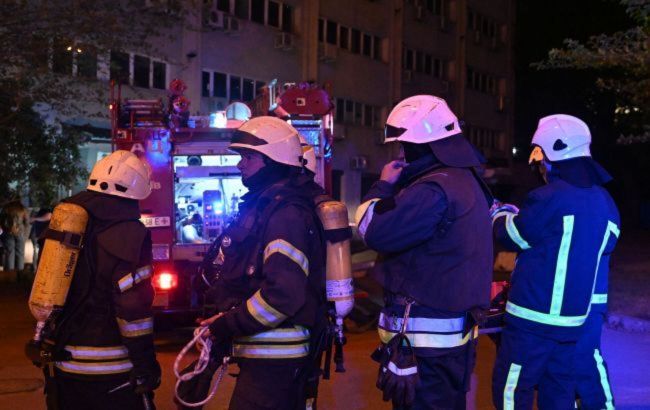First Known Attack By Underwater FPV Destroys Russian River Crossing

The submerged FPV, arrrowed, seconds before it detonated
Nothern Eagles, 151st Motorized Rifle BrigadeFollowing the drone war in Ukraine you get used to seeing some unusual things, from drones dropping Roman-era caltrops to burst tires to four FPVs lashed together to create a heavy lift drone. But this video of an underwater FPV destroying a Russian river crossing is definitely a first. (H/T to Tim White for spotting).
Submerged Shrike Special Edition
Serhii Flash via TelegramIn one sense this was no surprise. Back in February we reported on the Shrike Special Edition, a new version of Ukraine’s Shrike FPV attack drone capable of landing in water, submerging, and then taking off again. The new drone was even demonstrated in a video released by Ukrainian drone expert Serhii Flash.
At the time, it looked like the idea was for a new class of ambush drone, one that could lurk in ponds, lakes, flooded ditches, reservoirs and other watery hiding places, making it virtually impossible to spot. However, as the video shows, the submersible drone has other uses too.
Posted on Telegram by the Northen Eagle Battalion of the 151st Motorized Rifle Brigade, the video shows a river crossing in the Kharkiv region which has already been destroyed once. The remains of a road bridge can be seen in the water. The Russians have improvised a foot crossing over the gap with three logs the size of telegraph poles.
Enhanced view of the underwater FPV used by Northern Eagles
Nothern Eagles, 151st Motorized Rifle BrigadeThe video shows an FPV underwater nestled close to one end of the crossing. The drone blows up, with video pulling back to show that the crossing has been destroyed. (The caption says ‘Underwater FPV…Destroying an enemy crossing’’ and there is a link to donate to buy more drones).
This might cause the Russians some inconvenience, but destroying three logs is not a major loss and the target could as easily have been attacked with a bomber drone or just a conventional FPV. Why expend a special drone to blow up some logs?
One possibility is that the Shrike was in position waiting for soldiers attempting to cross, and that hiding underwater was the best way to conceal it. Waiting in ambush uses power, and the drone’s battery will have been running down. As the power bars started to dip, the operator may have chosen to detonate the drone rather risk it falling into enemy hands. (Some, if not all, FPVs are now rigged to explode if tampered with so letting them be captured is not always a bad idea. But nobody wants the Russians to capture a new design).
There is also the possibility that this was a trial run, a test to see whether the submersible FPV could hit a bridge target in actual combat conditions. In this case the operator may have deliberately chosen a time when there were no Russian soldiers around to make the attack as straightforward as possible.
One surprising feature is that the Shrike is downstream of the crossing. This is odd because the obvious way to attack a crossing like this would be to land upstream and let the current carry it into place (like the floating bridge-busting bombs used in the Caroline Moon operation in Vietnam). It may be that the approach from that side was not possible, but the operator managed to get the drone precisely in position anyway.
The video shows that submersible FPVs can destroy a target at or below water level. Knocking out three logs may not be significant, but successfully demonstrating a technology that can attack one of the toughest targets is far more important.
The Kerch Bridge was damaged by explosives placed by a large underwater drone. A fleet of ... More submersible FPVs might carry out the same type of mission.
Ukraine MoDIn this case a single drone was used on one-way mission. But the submersible drone could have placed the explosives and then returned to get more, like the minelaying drones which are widely used. Have several Shrikes ferrying explosives to the same spot underwater and you can start talking about attacking serious targets like bridge supports which are challenging even for air power. Flying submersible drones may have a much better chance of bypassing defenses than robot submarines
As we wrote previously, there are a lot of submersible multicopter drones out there in the consumer and academic sectors and even a few military ones, but few practical applications. Some are designed to propel themselves underwater as well as in air. This tends to be very inefficient, but as this Chinese TJ Flying Fish shows, multicopters can submerge, and travel and maneuver underwater with high precision. Communication underwater is an issue but not an insoluble one.
Small drones bring a transformational ability to rapidly deliver payloads several miles away with extreme precision. When this expands to include underwater targets, it opens up a whole new set of opportunities. This includes the intriguing possibility that FPVs could now target Russian submarines.
The river crossing attack appears to be the first recorded underwater action by an amphibious drone. Four months after being unveiled, the technology has been proven to work. Now we will see how it is used.










